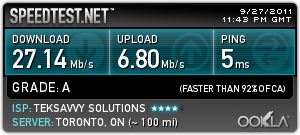I wanted a new system to run as my router, so I set out to find a small system with at least three gigabit NICs. I settled on a Jetway NF9H-525 (also referenced as a NF9HQL-525), which is a mini-ITX board geared for networking applications with four onboard gigabit NICs and a dual core atom 1.8Ghz processor. I also purchased an LGX MC500 case, two gigabytes of RAM, and pulled a drive out of a recently retired laptop. Bottom line: everything worked great and I would recommend it.
The board has four onboard realtek gigabit NICs (RTL8111/8168B) which use the re driver. They’re not the beloved Intel em NICs, but they’ll do. Especially for the types of applications this board is likely to be used for – like my home networking. Same deal with the intel atom processor. The system can be a bit louder than I would have really liked, but the fan speed stepping does work so it’s only loud when it’s under a bit of load.
I’m not going to bother including any build notes, mostly because I didn’t encounter any gotchas or oddities during the installation or configuration of the system. I read reports online that the NICs require a recent version of FreeBSD, but I didn’t have any issues with 9.2-RELEASE.
